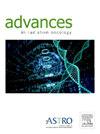使用对比增强和非对比增强计算机断层扫描图像预测边缘可切除胰腺癌远处转移的δ放射组学方法
IF 2.2
Q3 ONCOLOGY
引用次数: 0
摘要
目的通过对比增强计算机断层扫描(CECT)和非CECT图像计算三角放射组学特征,预测交界性可切除胰腺癌的远处转移(DM)。方法和材料在2013年2月至2021年12月期间在我们机构接受放射治疗的250例患者中,67例患者被认为符合条件。共纳入11个临床特征和3906个放射组学特征。从CECT和非CECT图像中提取放射组学特征,并计算这些特征之间的差异,得到delta-radiomics特征。将患者随机分为训练(70%)和测试(30%)数据集,用于模型开发和验证。采用Fine-Gray回归(FG)和随机生存森林(RSF),结合临床特征(临床模型)、放射组学特征(放射组学模型)以及上述特征的组合(混合模型)建立预测模型。采用分层5重交叉验证确定最佳超参数。随后,将开发的模型应用于剩余的测试数据集,并根据患者的风险评分将患者分为高风险组或低风险组。使用一致性指数评估预后能力,通过2000次自举迭代获得95%的ci。采用Gray检验评估各组间差异的统计学意义。结果在23.8个月的中位随访期内,47例(70.1%)患者发展为糖尿病。在试验数据集中,基于fg的临床模型、放射组学模型和混合模型的一致性指数分别为0.548、0.603和0.623,而基于rf的模型的一致性指数分别为0.598、0.680和0.727。基于rsf的模型,包括δ放射组学特征,显著地将累积发病率曲线分为两个风险组(P <;. 05)。灰度大小区矩阵的特征图显示CECT与非CECT影像特征值的差异与DM的发病率相关。结论RSF在CECT与非CECT影像上获得的δ放射组学特征可成功预测交界性可切除胰腺癌患者DM的发病率。本文章由计算机程序翻译,如有差异,请以英文原文为准。
Delta-Radiomics Approach Using Contrast-Enhanced and Noncontrast-Enhanced Computed Tomography Images for Predicting Distant Metastasis in Patients With Borderline Resectable Pancreatic Carcinoma
Purpose
To predict distant metastasis (DM) in patients with borderline resectable pancreatic carcinoma using delta-radiomics features calculated from contrast-enhanced computed tomography (CECT) and non-CECT images.
Methods and Materials
Among 250 patients who underwent radiation therapy at our institution between February 2013 and December 2021, 67 patients were deemed eligible. A total of 11 clinical features and 3906 radiomics features were incorporated. Radiomics features were extracted from CECT and non-CECT images, and the differences between these features were calculated, resulting in delta-radiomics features. The patients were randomly divided into the training (70%) and test (30%) data sets for model development and validation. Predictive models were developed with clinical features (clinical model), radiomics features (radiomics model), and a combination of the abovementioned features (hybrid model) using Fine-Gray regression (FG) and random survival forest (RSF). Optimal hyperparameters were determined using stratified 5-fold cross-validation. Subsequently, the developed models were applied to the remaining test data sets, and the patients were divided into high- or low-risk groups based on their risk scores. Prognostic power was assessed using the concordance index, with 95% CIs obtained through 2000 bootstrapping iterations. Statistical significance between the above groups was assessed using Gray's test.
Results
At a median follow-up period of 23.8 months, 47 (70.1%) patients developed DM. The concordance indices of the FG-based clinical, radiomics, and hybrid models were 0.548, 0.603, and 0.623, respectively, in the test data set, whereas those of the RSF-based models were 0.598, 0.680, and 0.727, respectively. The RSF-based model, including delta-radiomics features, significantly divided the cumulative incidence curves into two risk groups (P < .05). The feature map of the gray-level size-zone matrix showed that the difference in feature values between CECT and non-CECT images correlated with the incidence of DM.
Conclusions
Delta-radiomics features obtained from CECT and non-CECT images using RSF successfully predict the incidence of DM in patients with borderline resectable pancreatic carcinoma.
求助全文
通过发布文献求助,成功后即可免费获取论文全文。
去求助
来源期刊

Advances in Radiation Oncology
Medicine-Radiology, Nuclear Medicine and Imaging
CiteScore
4.60
自引率
4.30%
发文量
208
审稿时长
98 days
期刊介绍:
The purpose of Advances is to provide information for clinicians who use radiation therapy by publishing: Clinical trial reports and reanalyses. Basic science original reports. Manuscripts examining health services research, comparative and cost effectiveness research, and systematic reviews. Case reports documenting unusual problems and solutions. High quality multi and single institutional series, as well as other novel retrospective hypothesis generating series. Timely critical reviews on important topics in radiation oncology, such as side effects. Articles reporting the natural history of disease and patterns of failure, particularly as they relate to treatment volume delineation. Articles on safety and quality in radiation therapy. Essays on clinical experience. Articles on practice transformation in radiation oncology, in particular: Aspects of health policy that may impact the future practice of radiation oncology. How information technology, such as data analytics and systems innovations, will change radiation oncology practice. Articles on imaging as they relate to radiation therapy treatment.
 求助内容:
求助内容: 应助结果提醒方式:
应助结果提醒方式:


